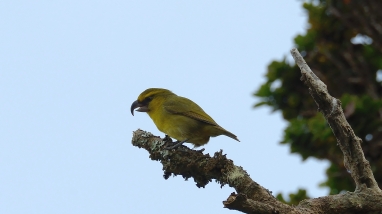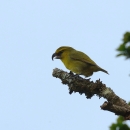Distribution: Kiwikiu currently occur on the windward slopes of East Maui in high elevation ʻōhiʻa forests, predominately in The Nature Conservancy’s Waikamoi Preserve, Hanawī Natural Area Reserve, and in Haleakalā National Park. Increases in climate favorable to mosquitoes has restricted kiwikiu to higher elevation habitats.
Behavior: Kiwikiu have low population densities, low reproductive rates, and a long juvenile dependency period. A population was successfully maintained in the conservation breeding program for over 20 years, but due to the low reproductive rate, the population did not increase. A reintroduction of captive-bred birds and translocated individuals to Nakula Natural Area Reserve was attempted in 2019. While the translocation was successful, all released birds eventually succumbed to avian malaria.
Current Status: Estimated wild population in 2021 is 135 individuals. In addition, there are two non-reproductive individuals in captivity. Estimated year of extinction is 2024 to 2032, most likely 2027.
Link to ECOS ECOS
Environmental Conservation Online System (ECOS) serves a variety of reports related to FWS Threatened and Endangered Species.
Learn more about ECOS https://ecos.fws.gov/ecp/species/7952




